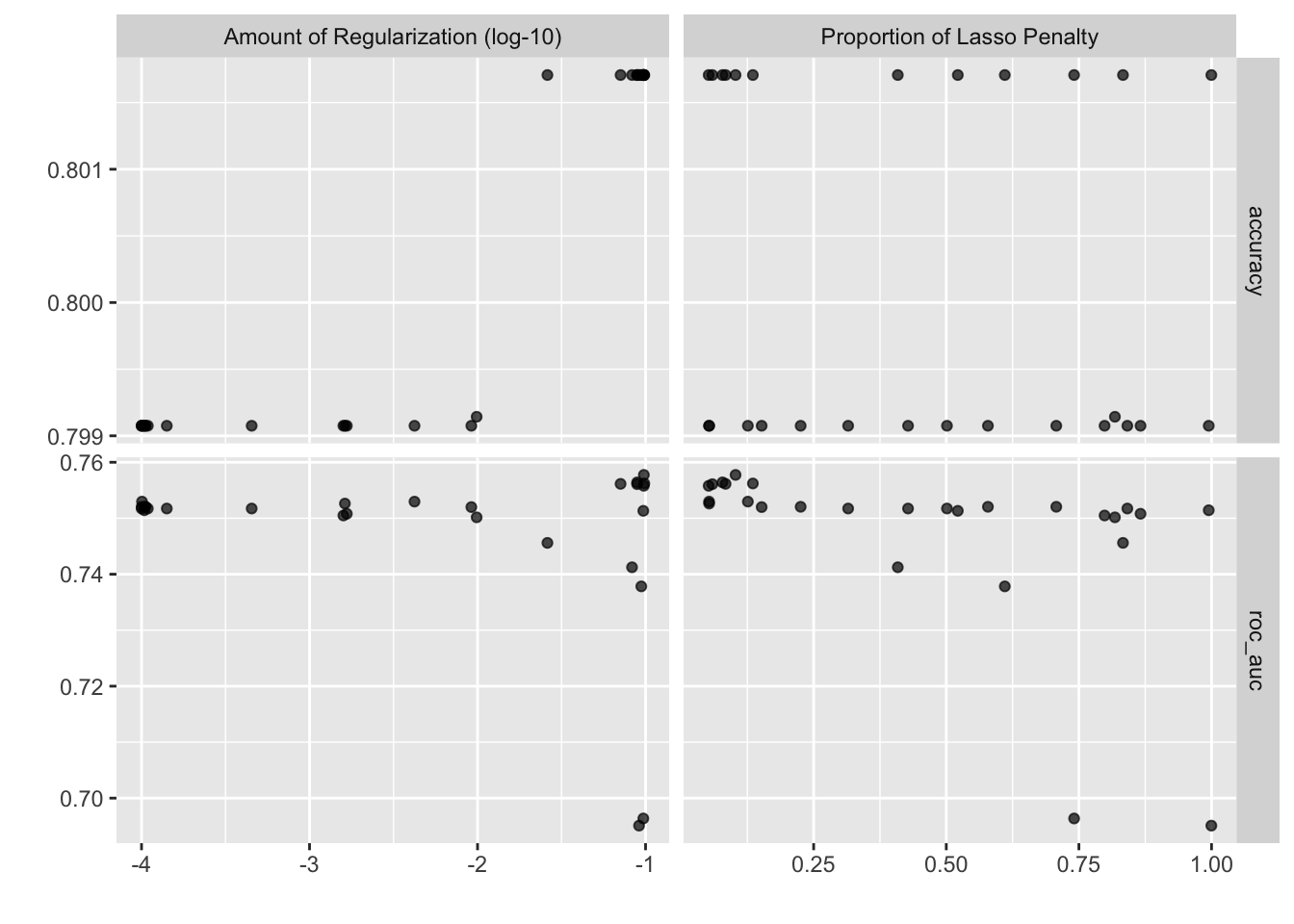Chapter 25 Model tuning
In this example, we will
- load and preprocess data
- define a workflow with tunable parameters
- tune the hyperparameters using Bayesian optimization
- train the final model
- evaluate the model using cross-validation and holdout data
using the Loan prediction dataset to illustrate the whole process.
Load the required packages:
Load and preprocess the data:
Code
data <- read_csv("https://gedeck.github.io/DS-6030/datasets/loan_prediction.csv",
show_col_types=FALSE) %>%
drop_na() %>%
mutate(
Gender=as.factor(Gender),
Married=as.factor(Married),
Dependents=gsub("\\+", "", Dependents) %>% as.numeric(),
Education=as.factor(Education),
Self_Employed=as.factor(Self_Employed),
Credit_History=as.factor(Credit_History),
Property_Area=as.factor(Property_Area),
Loan_Status=factor(Loan_Status, levels=c("N", "Y"), labels=c("No", "Yes"))
) %>%
select(-Loan_ID)Split dataset into training and holdout data, prepare for cross-validation:
Code
set.seed(123)
data_split <- initial_split(data, prop=0.8, strata=Loan_Status)
train_data <- training(data_split)
holdout_data <- testing(data_split)
resamples <- vfold_cv(train_data, v=10, strata=Loan_Status)
cv_metrics <- metric_set(roc_auc, accuracy)
cv_control <- control_resamples(save_pred=TRUE)Define the recipe, the model specification (elasticnet logistic regression), and combine them into a workflow:
Code
formula <- Loan_Status ~ Gender + Married + Dependents + Education + Self_Employed +
ApplicantIncome + CoapplicantIncome + LoanAmount + Loan_Amount_Term +
Credit_History + Property_Area
recipe_spec <- recipe(formula, data=train_data) %>%
step_dummy(all_nominal(), -all_outcomes())
model_spec <- logistic_reg(engine="glmnet", mode="classification",
penalty=tune(), mixture=tune())
wf <- workflow() %>%
add_model(model_spec) %>%
add_recipe(recipe_spec)Tune the penalty and mixture hyperparameters using Bayesian hyperparameter optimization:
Code
## ! No improvement for 10 iterations; returning current results.The autoplot of the tune_bayes object (Figure 25.1) shows the ROC-AUC for different values of the penalty and mixture hyperparameters. We can see that the best roc_auc is obtained with penalty and mixture values inside the tuning range. We don’t need to adjust the sampling ranges for the hyperparameters.

Figure 25.1: Autoplot shows the ROC-AUC for different values of the penalty and mixture hyperparameters.
Finalize the workflow:
Code
The best roc_auc is obtained with a penalty of best_parameter['penalty'] = 0.0632251 and a mixture of best_parameter['mixture'] = 0.7600721.
Use the tuned workflow for cross-validation and training the final model using the full dataset:
Code
Estimate model performance using the cross-validation results and the holdout data:
Code
cv_results <- collect_metrics(result_cv) %>%
select(.metric, mean) %>%
rename(.estimate=mean) %>%
mutate(result="Cross-validation")
holdout_predictions <- augment(fitted_model, new_data=holdout_data)
holdout_results <- bind_rows(
c(roc_auc(holdout_predictions, Loan_Status, .pred_Yes, event_level="second")),
c(accuracy(holdout_predictions, Loan_Status, .pred_class))) %>%
select(-.estimator) %>%
mutate(result="Holdout")The performance metrics are summarized in the following table.
Code
| result | accuracy | roc_auc |
|---|---|---|
| Cross-validation | 0.802 | 0.757 |
| Holdout | 0.835 | 0.741 |
Code
The code of this chapter is summarized here.
Code
knitr::opts_chunk$set(echo=TRUE, cache=TRUE, autodep=TRUE, fig.align="center")
library(tidyverse)
library(tidymodels)
data <- read_csv("https://gedeck.github.io/DS-6030/datasets/loan_prediction.csv",
show_col_types=FALSE) %>%
drop_na() %>%
mutate(
Gender=as.factor(Gender),
Married=as.factor(Married),
Dependents=gsub("\\+", "", Dependents) %>% as.numeric(),
Education=as.factor(Education),
Self_Employed=as.factor(Self_Employed),
Credit_History=as.factor(Credit_History),
Property_Area=as.factor(Property_Area),
Loan_Status=factor(Loan_Status, levels=c("N", "Y"), labels=c("No", "Yes"))
) %>%
select(-Loan_ID)
set.seed(123)
data_split <- initial_split(data, prop=0.8, strata=Loan_Status)
train_data <- training(data_split)
holdout_data <- testing(data_split)
resamples <- vfold_cv(train_data, v=10, strata=Loan_Status)
cv_metrics <- metric_set(roc_auc, accuracy)
cv_control <- control_resamples(save_pred=TRUE)
formula <- Loan_Status ~ Gender + Married + Dependents + Education + Self_Employed +
ApplicantIncome + CoapplicantIncome + LoanAmount + Loan_Amount_Term +
Credit_History + Property_Area
recipe_spec <- recipe(formula, data=train_data) %>%
step_dummy(all_nominal(), -all_outcomes())
model_spec <- logistic_reg(engine="glmnet", mode="classification",
penalty=tune(), mixture=tune())
wf <- workflow() %>%
add_model(model_spec) %>%
add_recipe(recipe_spec)
parameters <- extract_parameter_set_dials(wf) %>%
update(penalty=penalty(c(-4, -1)))
tune_wf <- tune_bayes(wf, resamples=resamples, metrics=cv_metrics,
param_info=parameters, iter=25)
autoplot(tune_wf)
best_parameter <- select_best(tune_wf, metric="roc_auc")
best_wf <- finalize_workflow(wf, best_parameter)
result_cv <- fit_resamples(best_wf, resamples,
metrics=cv_metrics, control=cv_control)
fitted_model <- best_wf %>% fit(train_data)
cv_results <- collect_metrics(result_cv) %>%
select(.metric, mean) %>%
rename(.estimate=mean) %>%
mutate(result="Cross-validation")
holdout_predictions <- augment(fitted_model, new_data=holdout_data)
holdout_results <- bind_rows(
c(roc_auc(holdout_predictions, Loan_Status, .pred_Yes, event_level="second")),
c(accuracy(holdout_predictions, Loan_Status, .pred_class))) %>%
select(-.estimator) %>%
mutate(result="Holdout")
bind_rows(
cv_results,
holdout_results
) %>%
pivot_wider(names_from=.metric, values_from=.estimate) %>%
kableExtra::kbl(caption="Model performance metrics", digits=3) %>%
kableExtra::kable_styling(full_width=FALSE)